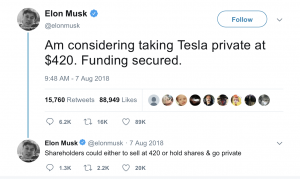I recently read “Power play: Elon Musk, Tesla and the bet of the country” written by Tim Higgins. It provided fascinating insights into the history and rise of Tesla. It also contained some rather juicy tidbits about Elon Musk and his management style. Musk has distanced himself from the contents of the aforementioned book and when asked for comments by the author he simply stated “..most, but not all, of what you read in this book is nonsense…”. A strong rebuke indeed.
Musk is by all accounts an interesting character. He grew up in South Africa and matriculated from Pretoria Boys High School in 1988. He apparently spent 5 months at the University of Pretoria before traveling to Canada, his mother’s homeland. He was reportedly a coding genius in his teens and subsequently started a a software company in 1995 which was later sold to Compaq for US$307 million in 1999. Musk was also a key shareholder in PayPal, which was sold to eBay in 2002 for US1.5 billion. It follows that he had plenty of capital which allowed him to pursue opportunities such as SpaceX, Tesla and SolarCity (subsequently acquired by Tesla). Forbes reported on 23 November 2021 that Musk was the world’s richest person with an estimated net worth of US$295 billion. Not bad for a boykie from Pretoria.
I follow Elon on Twitter and he can’t stop himself from tweeting some outrageous stuff at times. In July 2018, he offered to provide a submarine to be used to rescue those Thai teenage soccer players trapped in a cave. Vernon Unsworth, an experienced cave diver, took issue with Musk stating that “…Musk’s submarine had no chance of working, its just a PR stunt…”. This sparked a Twitter war with Musk eventually losing his cool and calling Unsworth a pedo.

Tesla’s share price has increased from US$86 at the start of 2020 to US$1,145 at the end of November 2021, a staggering annualized return of 287% over that period. Tesla manufactured and sold 25,202 electric vehicles in 2015. In the 2020 financial year, it managed to increase deliveries to just under 500,000 vehicles. In the nine months ended 30 September 2021, that number increased to 627,572. Until 2020, Tesla had incurred operating losses as it failed to generate sufficient revenue to cover research & development expenditure and operating costs. That changed dramatically in 2020 when Tesla reported EBITDA (earnings before interest, depreciation, amortization and taxation) of US$6 billion. No wonder the stock market richly rewarded Tesla shareholders with a dramatic rerating of the share.
I have analyzed Tesla’s financial performance for 2015 to 2020 – refer attached excel file Tesla Financial Analysis (November 2021). Despite all those operating losses, Tesla managed to survive the cash burn by borrowing more and more and also taking customer deposits for new vehicles ordered. It is a miracle that the group avoided bankruptcy. If lenders had lost confidence in Tesla’s ability to trade out of its predicament, it would have been game over.

Unlike most automotive groups, Tesla sells directly to its customers bypassing third party dealerships. It sells vehicles through its website and its own retail locations. Tesla also has its own vehicle service centers, mobile service technicians and supercharger stations. Tesla vehicles’ software is often remotely and automatically updated, with occasional glitches. In November 2021, Tesla recalled ±12,000 vehicles because of a communication error that may cause a false forward collision warning or unexpected activation of the emergency brakes. Later in the same month, hundreds of Tesla drivers were locked out of their cars after the manufacturer’s mobile app suffered an outage. That would have been rather inconvenient if it happened on a road trip.
Getting back to Musk’s Twitter escapades, he tweeted about taking Tesla private in August 2018.

The US Securities Exchange Commission (SEC) filed a compliant against Musk and Tesla alleging that Musk had lied about securing funding for the buyout of Tesla. It is extraordinary for a CEO of a listed company to divulge his intentions about buying out other shareholders on social media. There are clear rules about listed companies and their executives communicating potential corporate actions since these are price sensitive matters. The buyout price of US$420 was alleged related to the infamous time that many marijuana smokers light up their first joint of the day. Anyway, Musk’s misdemeanour cost Tesla a US$20 million fine and Musk agreed to step down as chairman of the company but remained on as CEO.
This did not stop Musk having a dig at the SEC later in 2018, referring to it as the ‘Shortseller Enrichment Commission’.
Tesla’s market capitalization (total value of the group on the stock exchange) is currently US$1.15 trillion. The Volkswagen group’s market capitalization is currently US$112.5 billion, roughly 10 times smaller. This is despite the fact that the VW automotive division sold 9.2 million vehicles in 2020 compared to Tesla’s ±500,000. The VW automotive division’s profitability is also over 9 times larger than Tesla’s. Clearly, investors are expecting electric powered vehicles to be ubiquitous in the next decade. Eskom better sort out its nonsense before that happens in sunny South Africa.
Stay safe and all the best from BeechieB.

Recent Comments